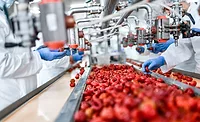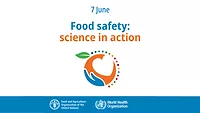How the Role of 'Art' in Food Safety Complements 'Science in Action'

Image credit: Freepik
The theme of this year's World Food Safety Day, organized by the World Health Organization (WHO) and the Food and Agriculture Organization of the United Nations (FAO), is "Science in Action." It emphasizes the importance of scientific advancements in establishing robust food safety standards, guidelines, and frameworks. World Food Safety Day is organized every year on June 7 by the WHO and FAO, with the objective of focusing global attention on the critical role of food safety in public health, economic growth, and sustainable food systems.
Science plays a fundamental role in food safety risk assessment. It drives the development of strong food safety management systems through research, technological innovations, and regulatory frameworks that help ensure food safety worldwide. However, this article examines the complementary role of "art," encapsulated by human skills and execution, in ensuring food safety.
Hazards analysis and critical control points (HACCP), for example, is based on science, but its effective implementation is an art—a skill that must be possessed by those responsible for its execution. While science provides the foundation, the successful implementation of food safety systems goes beyond science. This is where art plays a crucial role—in influencing human behavior, fostering communication, and shaping a strong food safety culture.
The Art of Food Safety Implementation: Bringing Food Safety Culture to Life
Food safety is not solely about microbiological limits, risk assessment models, and regulatory frameworks—it is also about the people who must understand and implement food safety management systems (FSMS). The way food handlers, managers, policymakers, and consumers perceive and engage with food safety is shaped by more than just rules and regulations. A blend of science and art is essential in ensuring that food safety standards are not just developed and documented, but also effectively implemented, understood, and sustained.
A strong food safety culture cannot be built through science alone. Compliance with standards is important, but true commitment comes when food safety is implanted in the values, attitudes, and daily behaviors of an organization. This requires effective communication, strong leadership, and behavioral transformation—key areas where human skills ("art") play a vital role.
Communication: The Art of Translating Science into Action
Food safety often remains confined to the food safety team leader or quality manager. A lack of engagement across all levels of an organization defeats the very purpose of an FSMS, which relies on both technical knowledge and effective execution to ensure food safety in practice. Key requirements for implementation of an FSMS include:
- The key responsibility of the food safety team leader and HACCP team is to ensure that the HACCP manual, standard operating procedures (SOPs), sanitation standard operating procedures (SSOPs), etc., are not just documented, but also effectively communicated and implemented on the production floor.
- Engaging people efficiently, fostering clear communication, and continuously monitoring their behavior and knowledge are crucial to bridging gaps in food safety practices.
- When food safety systems remain within documents, they represent science; but when translated into action through communication and implementation, they become a blend of both art and science.
- From top management to production floor personnel and suppliers, everyone within the organization must be aligned, engaged, and accountable for ensuring food safety through clear communication, implementation, and continuous improvement.
Leadership: The Art of Inspiring Change
A scientific approach to food safety sets strong standards, but effective leadership ensures that these standards are followed with dedication and consistency. Leadership in food safety is about influencing, guiding, and inspiring people to make food safety a daily practice rather than just a compliance requirement.
Key roles in food safety leadership include:
- Top management is the foundation of a strong food safety system. Management's commitment determines the priority food safety receives within an organization. Without their leadership, food safety policies remain on paper. They must allocate resources, set clear expectations, and ensure food safety is embedded in the company's culture.
- The food safety team leader ensures that food safety policies are not just developed and documented, but also effectively implemented. This role involves monitoring compliance, training employees, and fostering a culture of responsibility.
- The HACCP team plays a crucial role in identifying hazards, implementing control measures, and ensuring continuous improvement in food safety practices. A proactive and well-trained HACCP team is essential for maintaining safety at every stage of food production.
Leaders inspire change by leading through action, ensuring that their teams see food safety as a shared responsibility. When top management and corporate executives consistently follow food safety protocols, employees naturally adopt them.
Looking for quick answers on food safety topics?
Try Ask FSM, our new smart AI search tool.
Ask FSM →
Behavior: Shaping Safe Practices through Art
Ultimately, employee behavior within an organization is the key to a strong food safety culture. People come from diverse backgrounds, and it is the responsibility of the food safety team leader and the HACCP team to monitor individual behaviors—from top management to frontline personnel.
Providing informed feedback ensures that food safety is valued and ingrained as a way of life:
- Behavior drives food safety culture: Compliance is not just about procedures; it is about shaping the mindset of individuals to prioritize food safety in their daily actions. Even a 20-minute, focused discussion about food safety on the production floor has the potential to produce lasting benefits by cultivating a stronger food safety culture within the organization.
- Continuous monitoring and feedback: The HACCP team must observe and guide behavior across all levels, ensuring that corrective and preventive actions become habits, not just responses to incidents.
- Bridging knowledge gaps: Employees may have different levels of understanding due to their backgrounds, so targeted training, mentorship, and practical engagement are essential to align everyone with food safety goals.
- Embedding food safety into daily operations: The ultimate goal is to ensure that food safety practices are not seen as additional tasks, but as an integral part of the organization's work.
Food safety is not just about compliance with standards; it is about fostering a culture where every individual values it and practices it instinctively. Science provides the foundation, but behavioral engagement transforms it into a sustainable system.
The Fusion of Science and Art in Food Safety
While science establishes food safety systems, protocols, and risk assessment models, human skill ensures their effective implementation. Communication strategies, leadership approaches, behavior-shaping tools, and cultural transformations bridge the gap between theory and practice. Food safety is not just about compliance; it is about commitment, engagement, and culture.
This World Food Safety Day 2025, as we celebrate "Science in Action," let us also recognize the "art" in implementation, because only when science and art work together can we create a truly safe and sustainable food system for all.








